01 Radiometer of Crooks#
Aim#
To show the effect of pressure due to molecular recoil.
Subjects#
4D30 (Kinetic Motion)
Diagram#

Fig. 417 .#
Equipment#
Crooks’ radiometer.
Incandescent lamp, \(100 \mathrm{~W}\).
Presentation#
The radiometer is placed in the light beam of the incandescent lamp. The vanes of the radiometer will start rotating. Adjust the distance between the radiometer and lamp so the sense of rotation can be well observed: the black sides turn away from the light beam.
Explanation#
The radiometer has been evacuated to a pressure of approximately \(1 \mathrm{~Pa}\). Since the black sides of the vanes absorb more energy than the mirrored sides, the black sides become hotter. By conduction, the air in contact with the black sides becomes hotter than that in contact with the mirrored sides and so the air molecules close to the black sides have a higher impulse than those close to the mirrored sides. When colliding with the vanes the change in impulse is higher on the black sides and so the force exerted on the black sides is higher.
(The mean free path of the gas molecules at the pressure of \(1 \mathrm{~Pa}\) is about the size of the radiometer bulb, which allows for a particular efficient transfer of momentum between the gas molecules and the vanes.)
Remarks#
You can make the radiometer run backward when it is placed in the presence of a cold object.
An incorrect explanation often given for the rotation of the vanes is based on the different pressure of light photons on the black and mirrored sides. But this would require the vanes to rotate in the direction opposite to that actually observed. (See also the demonstration: Radiation pressure?.)
Sources#
Ehrlich, Robert, Turning the World Inside Out and 174 Other Simple Physics Demonstrations, pag. 117
Jewett Jr., John W., Physics Begins With Another M… : Mysteries, Magic, Myth, and Modern Physics, pag. 271-72
Sutton, Richard Manliffe, Demonstration experiments in Physics, pag. 242
